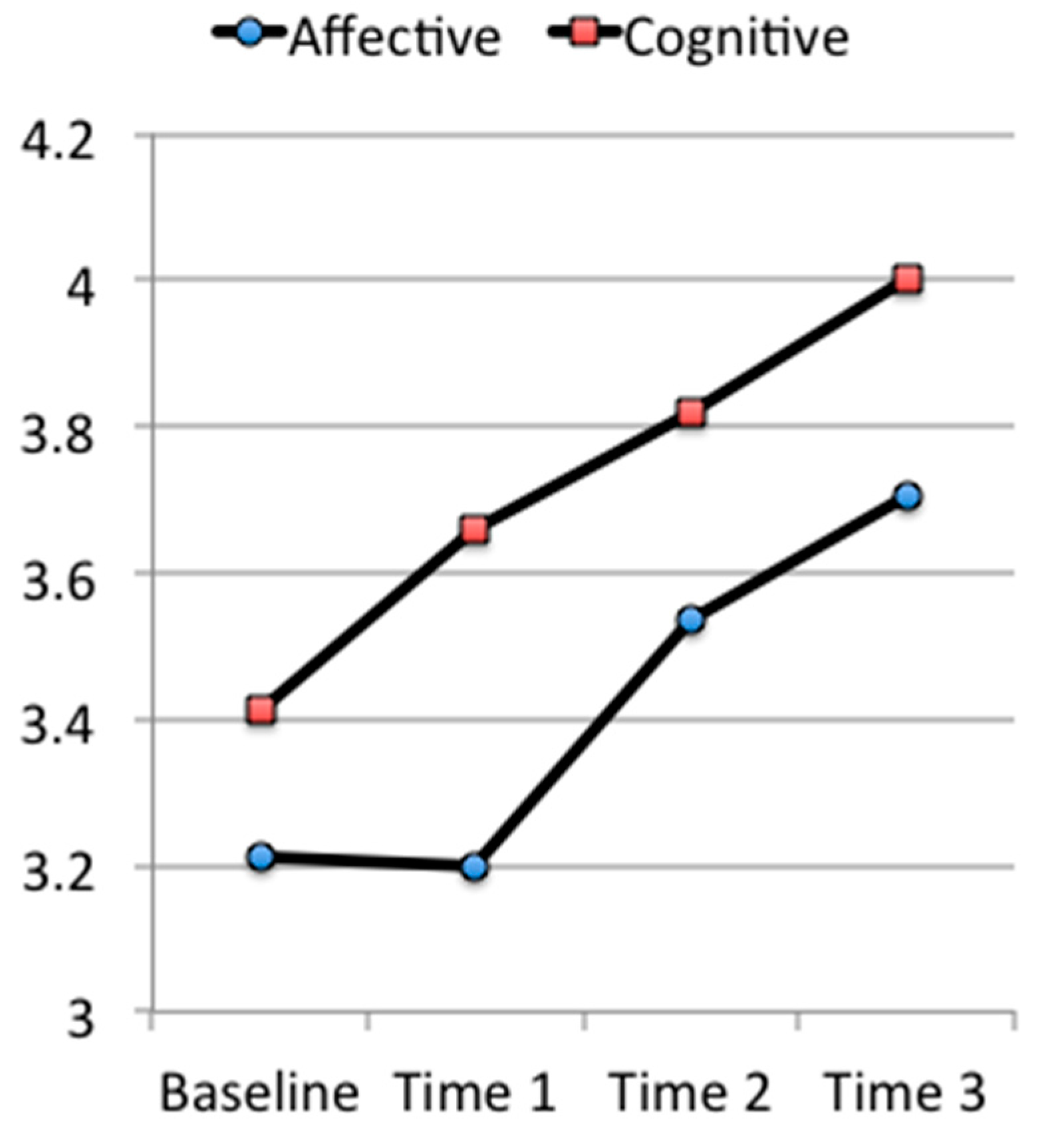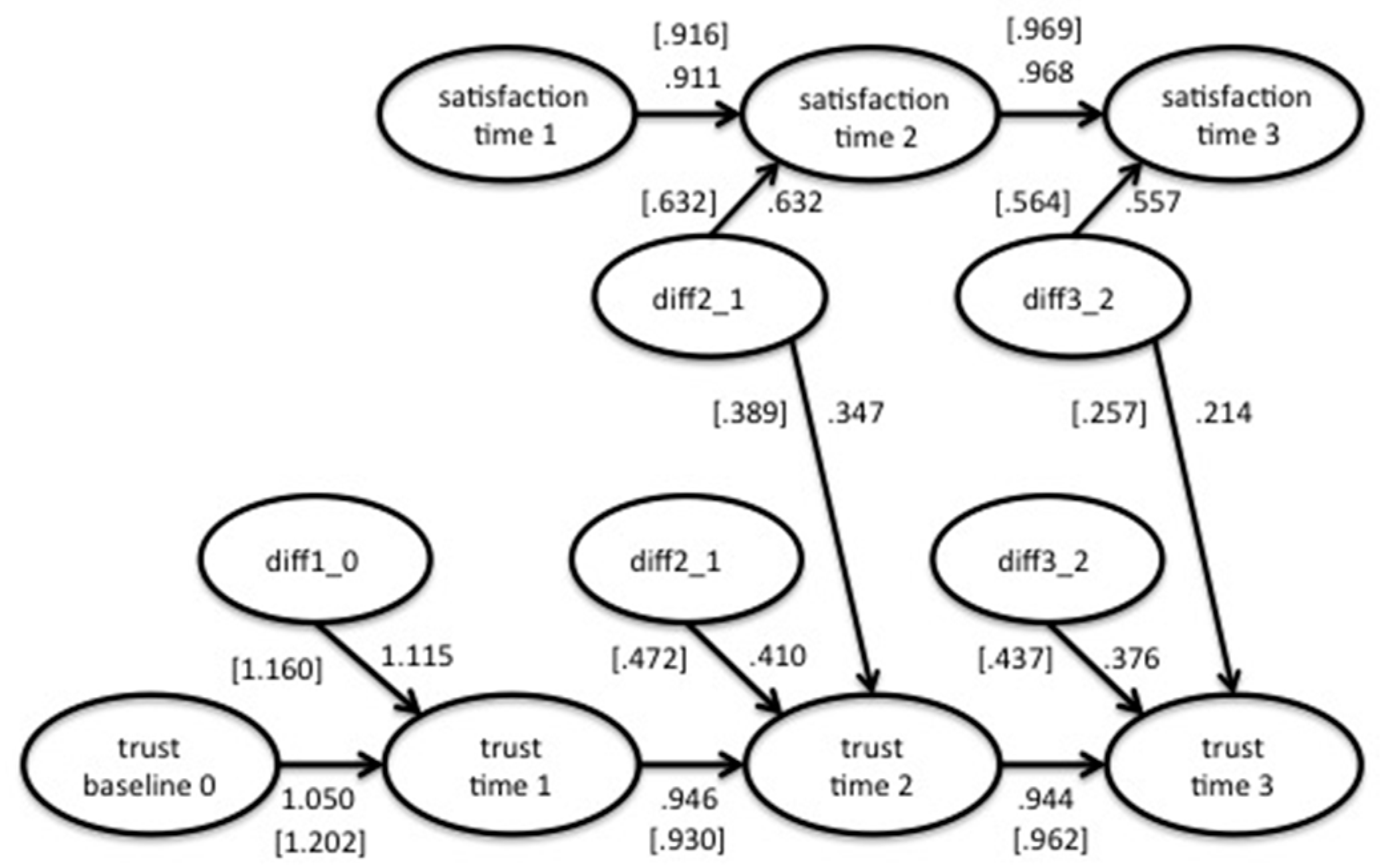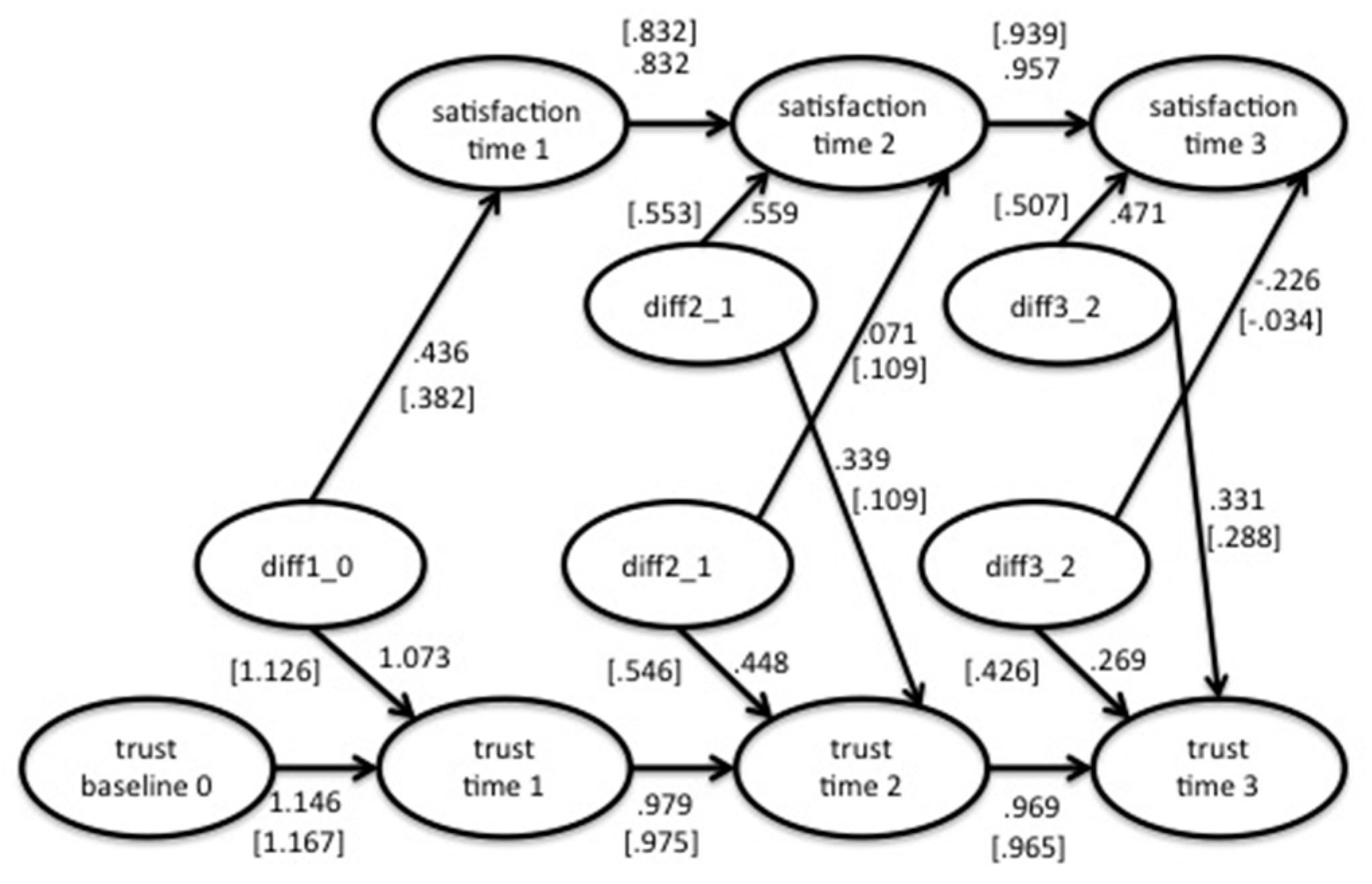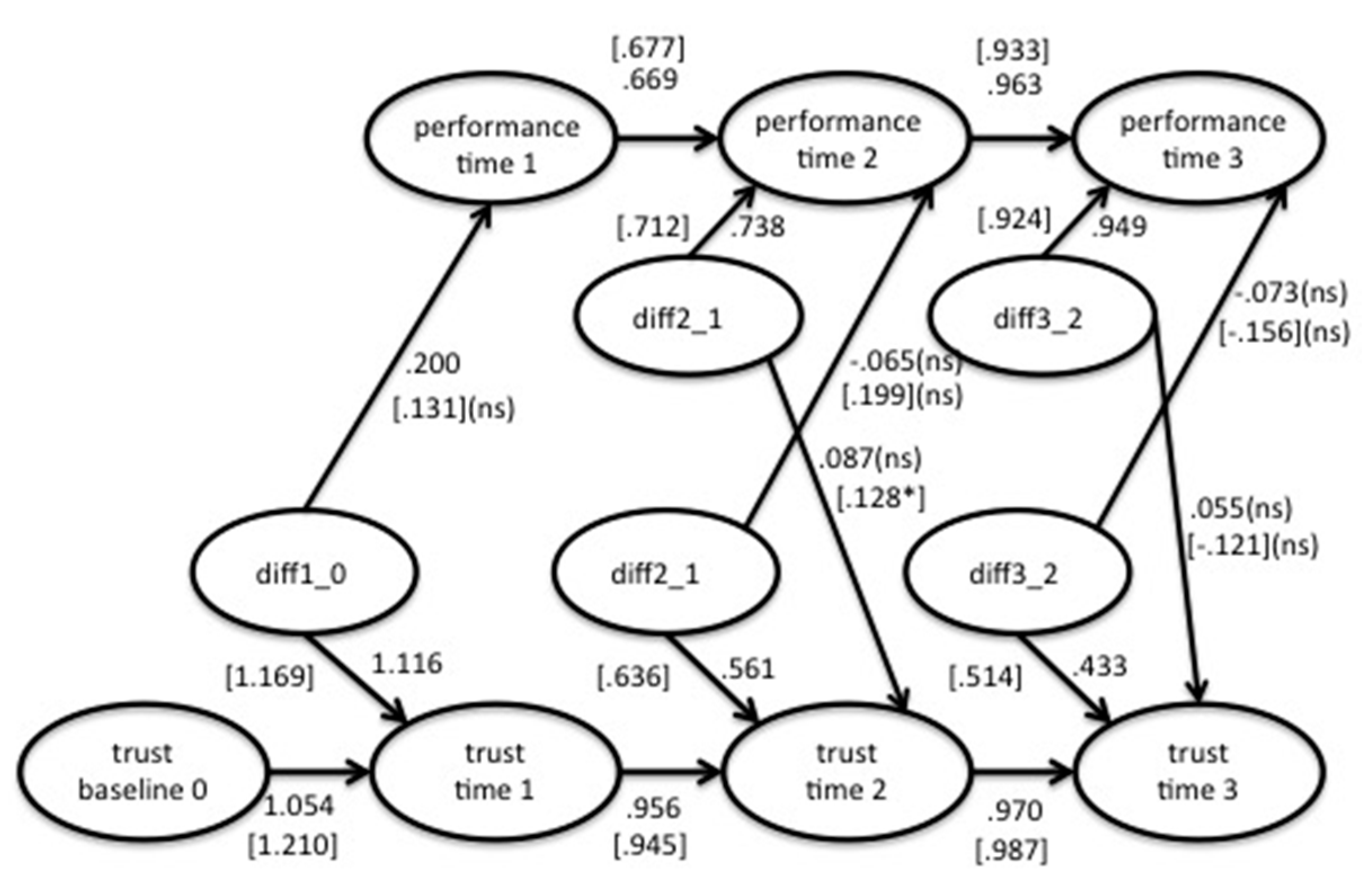Assessing Trust and Effectiveness in Virtual Teams: Latent Growth Curve and Latent Change Score Models
Abstract
:1. Introduction
1.1. What Is Trust?
1.2. The Importance of Trust in Virtual Teams
1.3. Trust and Satisfaction
1.4. Trust and Performance
Summary
1.5. Trust Development in a Virtual Environment—A Proposed Model and Hypotheses
2. Methodology
2.1. Participants
2.2 Materials
2.2.1. Search and Rescue Task
2.2.2. Team Trust
2.2.3. Team Satisfaction
2.2.4. Performance
2.3. Procedure
2.4. Analysis Strategy
- (1)
- Examine a confirmatory factor model reflecting the measurement of the construct over occasions. Examine factor intercorrelations to assess (1) latent state (intercorrelations close to 1.0); (2) latent state trait (small to medium intercorrelations); or (3) an autoregressive model (decreasing intercorrelations over time) (Geiser 2013, p. 84).
- (2)
- Examine an autoregressive model in which the temporal sequence is preserved.
- (3)
- Examine an indicator specific latent variable model that accounts for specific (non-random) indicator variance.
- (4)
- Examine a model involving invariant factor loadings.
- (5)
- Examine a full latent change model.
3. Results
3.1. Latent Growth Curve Analysis: Test of Hypothesis 1
3.1.1. Affective Trust
3.1.2. Cognitive Trust
3.1.3. Summary
3.2. Overview of Latent Change Analysis
3.3. Latent State Analysis of Trust
3.3.1. Hypothesis 2: Assessment of Affective Trust via Latent Change Score Modeling
Confirmatory Factor Model
Latent Autoregressive Model
Indicator Specific Latent Variable Model
Factorial Invariance Model
Latent Change of Affective Trust
3.3.2. Hypothesis 3: Assessment of Cognitive Trust via Latent Change Score Modeling
Latent Change of Cognitive Trust
3.4. Latent State Analysis of Satisfaction
Summary
3.5. Testing the Relationships between Trust and Satisfaction
3.5.1. Hypothesis 4a: Affective Trust and Satisfaction
Change in Affective Trust Influencing Satisfaction
Change in Satisfaction Influencing Change in Trust
Bivariate Coupling of Latent Change
3.5.2. Hypothesis 4b: Cognitive Trust and Satisfaction
Change in Cognitive Trust Influencing Satisfaction
Summary
3.6. Trust and Performance
3.6.1. Hypothesis 5a: Affective Trust and Performance
Summary
3.6.2. Hypothesis 5b: Cognitive Trust and Performance
Summary
3.7. Overall Summary of Results
3.7.1. Foundational Latent Change Analyses
3.7.2. Models of Theoretical and Substantive Interest
Satisfaction
Performance
3.7.3. General Summary
4. Discussion and Conclusions
4.1. Theoretical and Practical Implications
4.2. Limitations and Future Directions
Acknowledgments
Author Contributions
Conflicts of Interest
References
- Alge, Bradley J., Carolyn Wiethoff, and Howard J. Klein. 2003. When does the medium matter? Knowledge-building experiences and opportunities in decision-making teams. Organizational Behavior and Human Decision Processes 9: 26–37. [Google Scholar] [CrossRef]
- Altschuller, Shoshana, and Raquel Beneunan-Fich. 2010. Trust, performance, and the communication process in ad hoc decision-making virtual teams. Journal of Computer-Mediated Communication 16: 27–47. [Google Scholar] [CrossRef]
- Anderson, A. H., R. McEwan, J. Bal, and J. Carletta. 2007. Virtual team meetings: An analysis of communication and context. Computers in Human Behavior 23: 2558–80. [Google Scholar] [CrossRef]
- Aubert, Benoit A., and Barbara L. Kelsey. 2003. Further understanding of trust and performance in virtual teams. Small Group Research 34: 575–619. [Google Scholar] [CrossRef]
- Bandow, Diane. 2001. Time to create sound teamwork. The Journal of Quality and Participation 24: 41–47. [Google Scholar]
- Cohen, Susan, and Christina Gibson. 2003. In the beginning: Introduction and framework. In Virtual Teams that Work: Creating Conditions for Virtual Team Effectiveness. Edited by Susan Cohen and Christina Gibson. San Francisco: Jossey-Bass, pp. 1–13. [Google Scholar]
- Costa, Ana N. 2003. Work team trust and effectiveness. Personnel Review 32: 605–22. [Google Scholar] [CrossRef]
- Costa, Ana N., Robert A. Roe, and Tharsi Taillieu. 2001. Trust within teams: The relation with performance effectiveness. European Journal of Work and Organizational Psychology 10: 225–44. [Google Scholar] [CrossRef]
- Crisp, C. Brad, and Sirkka L. Jarvenpaa. 2013. Swift trust in global virtual teams: Trusting beliefs and normative actions. Journal of Personnel Psychology 12: 45–56. [Google Scholar] [CrossRef]
- Daft, Richard L., and Rovert H. Lengel. 1986. Organizational information requirements, media richness and structural design. Management Science 32: 554–71. [Google Scholar] [CrossRef]
- De Jong, Bart A., and Tom Elfring. 2010. How does trust affect the performance of ongoing teams? The mediating role of reflexivity, monitoring, and effort. Academy of Management Journal 53: 535–49. [Google Scholar] [CrossRef]
- DeRosa, Darleen M., Donald A. Hantula, Ned Kock, and John D’Arcy. 2004. Trust and leadership in virtual teamwork: A media naturalness perspective. Human Resource Management 43: 219–32. [Google Scholar] [CrossRef]
- Dirks, Kurt T., and Donald L. Ferrin. 2001. The role of trust in organizational settings. Organizational Science 12: 450–67. [Google Scholar] [CrossRef]
- Ferrer, Emilio, and John J. McArdle. 2010. Longitudinal modeling of developmental changes in psychological research. Current Directions in Psychological Science 19: 149–54. [Google Scholar] [CrossRef]
- Geiser, Christian. 2013. Data analysis with Mplus. New York: Guilford Press. [Google Scholar]
- Jarvenpaa, Sirkka L., and Dorthy E. Leidner. 1999. Communication and trust in global virtual teams. Journal of Computer Mediated Communication 3: 1–36. [Google Scholar] [CrossRef]
- Jarvenpaa, Sirkka L., Thomas R. Shaw, and D. Sandy Staples. 2004. Toward Contextualized Theories of Trust: The Role of Trust in Global Virtual Teams. Information Systems Research 15: 250–67. [Google Scholar] [CrossRef]
- Jones, Gareth R., and Jennifer M. George. 1998. The experience and evolution of trust: Implications for cooperation and teamwork. Academy of Management Review 23: 531–46. [Google Scholar]
- Kirkman, Bradley L., and John E. Mathieu. 2005. The dimensions and antecedents of team virtuality. Journal of Management 31: 700–18. [Google Scholar] [CrossRef]
- Kuo, Feng-yang, and Chai-ping Yu. 2009. An exploratory study of trust dynamics in work-oriented virtual teams. Journal of Computer-Mediated Communication 14: 823–54. [Google Scholar] [CrossRef]
- Lancellotti, Matthew P., and Thomas Boyd. 2008. The Effects of Team Personality Awareness Exercises on Team Satisfaction and Performance. Journal of Marketing Education 30: 244–54. [Google Scholar] [CrossRef]
- Lee, John D., and Katrina A. See. 2004. Trust in automation: Designing for appropriate reliance. Human Factors 46: 50–80. [Google Scholar] [CrossRef] [PubMed]
- LeMay, Elaine A. 2000. Virtual Teams: Work Processes, Communication, and Team Development. Ph.D. Dissertation, Colorado State University, Fort Collins, CO, USA. [Google Scholar]
- LePine, Jeffery A., Ronald F. Piccolo, Christine L. Jackson, John E. Mathieu, and Jessica R. Saul. 2008. A meta-analysis of teamwork process: Tests of a multidimensional model and relationships with team effectiveness criteria. Personnel Psychology 61: 273–307. [Google Scholar] [CrossRef]
- Lewicki, Roy J., and Barbara Benedict Bunker. 1996. Developing and maintaining trust in work relationships. In Trust in Organizations: Frontiers of Theory and Research. Edited by Roderick M. Kramer and Tom R. Tyler. Thousand Oaks: Sage Publications, pp. 114–39. [Google Scholar]
- Lewicki, Roy J., Edward C. Tomlinson, and Nicole Gillespie. 2006. Models of interpersonal trust development: Theoretical approaches, empirical evidence, and future directions. Journal of Management 32: 991–1024. [Google Scholar] [CrossRef]
- MacCallum, Robert C., Michael Browne, and Hazuki Sugawara. 1996. Power analysis and determination of sample size for covariance structure modeling. Psychological Methods 1: 130–49. [Google Scholar] [CrossRef]
- MacDonnell, Rhiannon, Thomas O’Neill, Theresa Kline, and Laura Hambley. 2009. Bringing group-level personality to the electronic realm: A comparison of face-to-face and virtual contexts. The Psychologist-Manager Journal 12: 1–24. [Google Scholar] [CrossRef]
- Mayer, Roger, James Davis, and F. David Schoorman. 1995. An integrative model of organizational trust. Academy of Management Review 20: 709–36. [Google Scholar]
- McAllister, Daniel J. 1995. Affect-and cognition-based trust as foundations for interpersonal cooperation in organizations. Academy of Management Journal 38: 24–59. [Google Scholar] [CrossRef]
- McArdle, John J. 2009. Latent variable modeling of differences and changes with longitudinal data. Annual Review of Psychology 60: 577–605. [Google Scholar] [CrossRef] [PubMed]
- McArdle, John J., and Fumiaki Hamagami. 2004. Methods for dynamic change hypotheses. In Recent Developments on Structural Equation Models. Edited by K. van Montfort, J. Oud and A. Satorra. Dordrecht: Kluwer Academic Publishers, pp. 295–335. [Google Scholar]
- McEvily, Bill, and Marco Tortoriello. 2011. Measuring trust in organisational research: Review and recommendations. Journal of Trust Research 1: 23–63. [Google Scholar] [CrossRef]
- Meredith, William, and John Horn. 2001. The role of factorial invariance in modeling growth and change. In New Methods for the Analysis of Change. Edited by L. M. Collins and A. G. Sayer. Washington: American Psychological Association, pp. 203–40. [Google Scholar]
- Palanski, Michael E., Surinder S. Kahai, and Francis J. Yammarino. 2011. Team virtues and performance: An examination of transparency, behavioral integrity, and trust. Journal of Behavioral Ethics 99: 201–16. [Google Scholar] [CrossRef]
- Peters, Linda, and Ronald J. Karren. 2009. An examination of the roles of trust and functional diversity on virtual team performance ratings. Group and Organization Management 34: 479–504. [Google Scholar] [CrossRef]
- Powell, Anne, Gabriele Piccoli, and Blake Ives. 2004. Virtual teams: Team control structure, work processes, and team effectiveness. Information Technology & People 17: 359–79. [Google Scholar]
- Raykov, Tenko. 1993. A structural equation model for measuring residualized change and discerning patterns of growth or decline. Applied Psychological Measurement 17: 53–71. [Google Scholar] [CrossRef]
- Riegelsberger, Jens, M. Angela Sasse, and John D. McCarthy. 2003. The researcher’s dilemma: Evaluating trust in computer-mediated communication. International Journal of Human-Computer Studies 58: 759–81. [Google Scholar] [CrossRef]
- Rusman, Ellen, Jan van Bruggen, Peter Sloep, and Rob Koper. 2010. Fostering trust in virtual project teams: Towards a design framework grounded in a TrustWorthiness ANtecedents (TWAN) schema. International Journal of Human-Computer Studies 68: 834–50. [Google Scholar] [CrossRef]
- Salas, Eduardo, Dana E. Sims, and C. Shawn Burke. 2005. Is there a "Big Five" in teamwork? Small Group Research 36: 555–99. [Google Scholar] [CrossRef]
- Schiller, Shu Z., Brian E. Mennecke, Fiona Fui-Hoon Nah, and Andy Luse. 2014. Institutional boundaries and trust of virtual teams in collaborative design: An experimental study in a virtual world environment. Computers in Human Behavior 35: 565–77. [Google Scholar] [CrossRef]
- Smith, J. Brock, and Donald W. Barclay. 1997. The effect of organizational differences and trusting on the effectiveness of selling partner relationships. Journal of Marketing 61: 3–21. [Google Scholar] [CrossRef]
- Thompson, Lori, and Michael D. Coovert. 2006. Understanding and developing virtual computer-supported cooperative work teams. In Creating High-Tech Teams: Practical Guide to Work Performance and Technology. Edited by Clint Bowers, Eduardo Salas and Florien Jentsch. Washington: APA, pp. 213–41. [Google Scholar]
- Walther, Joseph B. 1992. Interpersonal Effects in Computer-Mediated Interaction—A Relational Perspective. Communication Research 19: 52–90. [Google Scholar] [CrossRef]
- Webber, Shelia S. 2008. Development of cognitive and affective trust in teams: A longitudinal study. Small Group Research 39: 746–69. [Google Scholar] [CrossRef]
- Widaman, Keith F., and Steven P. Reise. 1997. Exploring the measurement invariance of psychological instruments: Applications in the substance use domain. In The Science of Prevention: Methodological Advances from Alcohol and Substance Abuse Research. Edited by Kendall. J. Bryant, Michael Windle and Stephen G. West. Washington: American Psychological Association, pp. 281–324. [Google Scholar]
- Wilson, Jeanne M., Susan G. Straus, and Bill McEvily. 2006. All in due time: The development of trust in computer-mediated and face-to-face teams. Organizational Behavior and Human Decision Processes 99: 16–33. [Google Scholar] [CrossRef]
- Zornoza, Ana, Virginia Orengo, and Vicente Peñarroja. 2009. Relational capital in virtual teams: The role played by trust. Social Science Information 48: 257–81. [Google Scholar] [CrossRef]





| Model | Χ2 | df | RMSEA | CFI | TLI | SRMR |
|---|---|---|---|---|---|---|
| Affective Trust | ||||||
| Null | 3459.85 | 120 | ||||
| Confirmatory factor model. Four intercorrelated trust factors | 599.84 | 98 | 0.131 | 0.850 | 0.816 | 0.063 |
| Latent autoregressive model | 608.14 | 101 | 0.130 | 0.848 | 0.820 | 0.063 |
| Baseline -> T1 -> T2 -> T3 | ||||||
| Autoregressive adding indicator specific latent variables | 168.16 | 86 | 0.057 | 0.975 | 0.966 | 0.037 |
| Autoregressive, indicator specific LVs, adding invariant factor loadings | 228.76 | 97 | 0.068 | 0.961 | 0.951 | 0.087 |
| Latent change model: invariant factor loadings and intercepts | 272.24 | 101 | 0.076 | 0.949 | 0.939 | 0.086 |
| Cognitive Trust | ||||||
| Null | 3498.94 | 120 | ||||
| Latent change model: invariant factor loadings and intercepts | 217.756 | 101 | 0.062 | 0.965 | 0.959 | 0.082 |
| Model | Χ2 | df | p | RMSEA | CFI | TLI | SRMR |
|---|---|---|---|---|---|---|---|
| Null | 2378.20 | 36 | 0.000 | ||||
| Confirmatory factor model. Three intercorrelated satisfaction factors | 146.72 | 24 | 0.000 | 0.131 | 0.948 | 0.921 | 0.057 |
| Latent autoregressive model | 150.35 | 25 | 0.000 | 0.130 | 0.946 | 0.923 | 0.060 |
| S1 -> S2 -> S3 | |||||||
| Autoregressive adding indicator specific latent variables | 40.98 | 18 | 0.002 | 0.066 | 0.990 | 0.980 | 0.035 |
| Autoregressive, indicator specific LVs, adding invariant factor loadings | 60.94 | 22 | 0.000 | 0.077 | 0.983 | 0.987 | 0.064 |
| Latent change model: invariant factor loadings and intercepts | 66.30 | 25 | 0.000 | 0.075 | 0.982 | 0.975 | 0.064 |
| Model | Χ2 | df | p | RMSEA | CFI | TLI | SRMR |
|---|---|---|---|---|---|---|---|
| Change in affective trust influencing satisfaction | |||||||
| Null | 6300.69 | 300 | 0.000 | ||||
| A. Change in trust directly influencing satisfaction (see Figure 2) | 666.16 | 269 | 0.000 | 0.070 | 0.934 | 0.926 | 0.178 |
| B. Change in trust influencing change in satisfaction | 719.99 | 271 | 0.000 | 0.075 | 0.925 | 0.917 | 0.216 |
| Model comparison, model A vs. model B | 53.83 | 2 | 0.001 | ||||
| Change in satisfaction influencing affective trust | |||||||
| C. Change in satisfaction directly influencing trust (see Figure 3) | 694.96 | 268 | 0.000 | 0.073 | 0.929 | 0.920 | 0.215 |
| D. Change in satisfaction influencing change in trust | 717.20 | 273 | 0.000 | 0.074 | 0.926 | 0.919 | 0.217 |
| Model comparison, model C vs. model D. | 22.24 | 5 | 0.001 | ||||
| Bi-variant coupling change model | |||||||
| E. Combines parameters: Change in trust influencing satisfaction (model A) with Change in satisfaction influencing trust (model C), (see Figure 4). | 652.096 | 267 | 0.000 | 0.070 | 0.936 | 0.928 | 0.165 |
| Model E vs. Model A | 14.064 | 2 | 0.001 | ||||
| Model E vs. Model C | 42.860 | 1 | 0.001 | ||||
| Model | Χ2 | df | p | RMSEA | CFI | TLI | SRMR |
|---|---|---|---|---|---|---|---|
| Change in trust influencing satisfaction | |||||||
| Null | 6298.62 | 300 | |||||
| A. Change in trust directly influencing satisfaction. See Figure 2, parameter estimates in [ ]. | 584.423 | 269 | 0.000 | 0.063 | 0.947 | 0.941 | 0.201 |
| Change in satisfaction influencing trust | |||||||
| C. Change in satisfaction directly influencing trust. See Figure 4 parameter estimates in [ ]. | 599.18 | 268 | 0.000 | 0.065 | 0.945 | 0.938 | 0.214 |
| Bi-variant coupling change model | |||||||
| E. Combines parameters: Change in trust influencing satisfaction (model A) with Change in satisfaction influencing trust (model C). | 577.72 | 267 | 0.000 | 0.063 | 0.948 | 0.942 | 0.185 |
| Model A vs. Model E | 6.703 | 2 | 0.048 | ||||
| Model C vs. Model E | 22.46 | 1 | 0.001 | ||||
| Trust Type | Model | Χ2 | df | p | RMSEA | CFI | TLI | SRMR |
|---|---|---|---|---|---|---|---|---|
| Change in trust influencing performance | ||||||||
| Affective | Null | 3800.56 | 231 | |||||
| Cognitive | Null | 3859.65 | 231 | |||||
| Affective | A. Change in trust influencing performance. | 426.704 | 203 | 0.000 | 0.061 | 0.937 | 0.929 | 0.083 |
| Cognitive | B. Change in trust influencing performance. | 393.080 | 204 | 0.000 | 0.056 * | 0.948 | 0.941 | 0.087 |
| Change in performance influencing trust | ||||||||
| Affective | C. Change in performance influencing trust. | 408.47 | 202 | 0.000 | 0.059 | 0.942 | 0.934 | 0.082 |
| Cognitive | D. Change in performance influencing trust | 370.686 | 203 | 0.000 | 0.053 * | 0.954 | 0.947 | 0.086 |
| Bi-variant coupling change model | ||||||||
| Affective | E. Combines parameters: Change in trust influencing performance with Change in satisfaction influencing trust | 426.417 | 201 | 0.000 | 0.061 | 0.937 | 0.927 | 0.084 |
| F. Parsimonious. Same as model E, but fix non significant paths to zero. | 427.101 | 205 | 0.000 | 0.060 | 0.938 | 0.930 | 0.083 | |
| Model E vs. Model F | 0.684 | 4 | ns | |||||
| Cognitive | G. Combines parameters: Change in trust influencing performance with change in satisfaction influencing trust | 392 | 202 | 0.000 | 0.056 * | 0.948 | 0.940 | 0.088 |
| H. Parsimonious. Same as model G, but fix non significant paths in model B and D to zero. | 370.788 | 204 | 0.000 | 0.052 * | 0.954 | 0.948 | 0.086 | |
© 2017 by the authors. Licensee MDPI, Basel, Switzerland. This article is an open access article distributed under the terms and conditions of the Creative Commons Attribution (CC BY) license (http://creativecommons.org/licenses/by/4.0/).
Share and Cite
Coovert, M.D.; Miller, E.E.P.; Jr., W.B. Assessing Trust and Effectiveness in Virtual Teams: Latent Growth Curve and Latent Change Score Models. Soc. Sci. 2017, 6, 87. https://doi.org/10.3390/socsci6030087
Coovert MD, Miller EEP, Jr. WB. Assessing Trust and Effectiveness in Virtual Teams: Latent Growth Curve and Latent Change Score Models. Social Sciences. 2017; 6(3):87. https://doi.org/10.3390/socsci6030087
Chicago/Turabian StyleCoovert, Michael D., Evgeniya E. Pavlova Miller, and Winston Bennett Jr. 2017. "Assessing Trust and Effectiveness in Virtual Teams: Latent Growth Curve and Latent Change Score Models" Social Sciences 6, no. 3: 87. https://doi.org/10.3390/socsci6030087




